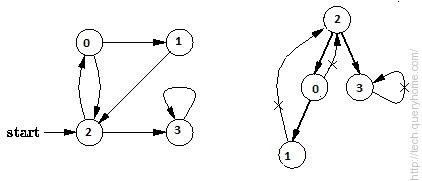For Example:
Given a directed graph, check whether the graph contains a cycle or not. Your function should return true if the given graph contains at least one cycle, else return false. For example, the following graph contains three cycles 0->2->0, 0->1->2->0 and 3->3, so your function must return true.
Solution
Depth First Traversal can be used to detect cycle in a Graph. DFS for a connected graph produces a tree. There is a cycle in a graph only if there is a back edge present in the graph. A back edge is an edge that is from a node to itself (selfloop) or one of its ancestor in the tree produced by DFS. In the following graph, there are 3 back edges, marked with cross sign. We can observe that these 3 back edges indicate 3 cycles present in the graph.

For a disconnected graph, we get the DFS forrest as output. To detect cycle, we can check for cycle in individual trees by checking back edges.
To detect a back edge, we can keep track of vertices currently in recursion stack of function for DFS traversal. If we reach a vertex that is already in the recursion stack, then there is a cycle in the tree. The edge that connects current vertex to the vertex in the recursion stack is back edge. We have used recStack[] array to keep track of vertices in the recursion stack.
// A C++ Program to detect cycle in a graph
#include<iostream>
#include <list>
#include <limits.h>
using namespace std;
class Graph
{
int V; // No. of vertices
list<int> *adj; // Pointer to an array containing adjacency lists
bool isCyclicUtil(int v, bool visited[], bool *rs); // used by isCyclic()
public:
Graph(int V); // Constructor
void addEdge(int v, int w); // to add an edge to graph
bool isCyclic(); // returns true if there is a cycle in this graph
};
Graph::Graph(int V)
{
this->V = V;
adj = new list<int>[V];
}
void Graph::addEdge(int v, int w)
{
adj[v].push_back(w); // Add w to v’s list.
}
bool Graph::isCyclicUtil(int v, bool visited[], bool *recStack)
{
if(visited[v] == false)
{
// Mark the current node as visited and part of recursion stack
visited[v] = true;
recStack[v] = true;
// Recur for all the vertices adjacent to this vertex
list<int>::iterator i;
for(i = adj[v].begin(); i != adj[v].end(); ++i)
{
if ( !visited[*i] && isCyclicUtil(*i, visited, recStack) )
return true;
else if (recStack[*i])
return true;
}
}
recStack[v] = false; // remove the vertex from recursion stack
return false;
}
// Returns true if the graph contains a cycle, else false.
bool Graph::isCyclic()
{
// Mark all the vertices as not visited and not part of recursion
// stack
bool *visited = new bool[V];
bool *recStack = new bool[V];
for(int i = 0; i < V; i++)
{
visited[i] = false;
recStack[i] = false;
}
// Call the recursive helper function to detect cycle in different
// DFS trees
for(int i = 0; i < V; i++)
if (isCyclicUtil(i, visited, recStack))
return true;
return false;
}
int main()
{
// Create a graph given in the above diagram
Graph g(4);
g.addEdge(0, 1);
g.addEdge(0, 2);
g.addEdge(1, 2);
g.addEdge(2, 0);
g.addEdge(2, 3);
g.addEdge(3, 3);
if(g.isCyclic())
cout << "Graph contains cycle";
else
cout << "Graph doesn't contain cycle";
return 0;
}
Output:
Graph contains cycle
Time Complexity of this method is same as time complexity of DFS traversal which is O(V+E).
